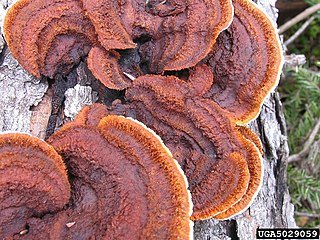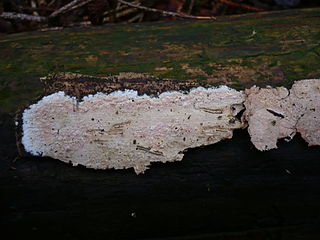
Secotioid fungi are an intermediate growth form between mushroom-like hymenomycetes and closed bag-shaped gasteromycetes, where an evolutionary process of gasteromycetation has started but not run to completion. Secotioid fungi may or may not have opening caps, but in any case they often lack the vertical geotropic orientation of the hymenophore needed to allow the spores to be dispersed by wind, and the basidiospores are not forcibly discharged or otherwise prevented from being dispersed —note—some mycologists do not consider a species to be secotioid unless it has lost ballistospory.

The Polyporales are an order of about 1800 species of fungi in the division Basidiomycota. The order includes some polypores as well as many corticioid fungi and a few agarics. Many species within the order are saprotrophic, most of them wood-rotters. Some genera, such as Ganoderma and Fomes, contain species that attack living tissues and then continue to degrade the wood of their dead hosts. Those of economic importance include several important pathogens of trees and a few species that cause damage by rotting structural timber. Some of the Polyporales are commercially cultivated and marketed for use as food items or in traditional Chinese medicine.

The Agaricales are an order of fungi in the division Basidiomycota. As originally conceived, the order contained all the agarics, but subsequent research has shown that not all agarics are closely related and some belong in other orders, such as the Russulales and Boletales. Conversely, DNA research has also shown that many non-agarics, including some of the clavarioid fungi and gasteroid fungi belong within the Agaricales. The order has 46 extant families, more than 400 genera, and over 25,000 described species, along with six extinct genera known only from the fossil record. Species in the Agaricales range from the familiar Agaricus bisporus and the deadly Amanita virosa to the coral-like Clavaria zollingeri and bracket-like Fistulina hepatica.

Polypores are a group of fungi that form large fruiting bodies with pores or tubes on the underside. They are a morphological group of basidiomycetes-like gilled mushrooms and hydnoid fungi, and not all polypores are closely related to each other. Polypores are also called bracket fungi or shelf fungi, and they characteristically produce woody, shelf- or bracket-shaped or occasionally circular fruiting bodies that are called conks.

The Boletaceae are a family of mushroom-forming fungi, primarily characterised by small pores on the spore-bearing hymenial surface, instead of gills as are found in most agarics. Nearly as widely distributed as the agarics, the family is renowned for hosting some prime edible species highly sought after by mushroom hunters worldwide, such as the cep or king bolete . A number of rare or threatened species are also present in the family, that have become the focus of increasing conservation concerns. As a whole, the typical members of the family are commonly known as boletes.

The Hygrophoraceae are a family of fungi in the order Agaricales. Originally conceived as containing white-spored, thick-gilled agarics, including Hygrophorus and Hygrocybe species, DNA evidence has extended the limits of the family, so it now contains not only agarics, but also basidiolichens and corticioid fungi. Species are thus diverse and are variously ectomycorrhizal, lichenized, associated with mosses, or saprotrophic. The family contains 34 genera and over 1000 species. None is of any great economic importance, though fruit bodies of some Hygrocybe and Hygrophorus species are considered edible and may be collected for sale in local markets.

The Tricholomataceae are a large family of fungi within the order Agaricales. Originally a classic "wastebasket taxon", the family included any white-, yellow-, or pink-spored genera in the Agaricales not already classified as belonging to e.g. the Amanitaceae, Lepiotaceae, Hygrophoraceae, Pluteaceae, or Entolomataceae.

The Agaricomycetes are a class of fungi in the division Basidiomycota. The taxon is roughly identical to that defined for the Homobasidiomycetes by Hibbett & Thorn, with the inclusion of Auriculariales and Sebacinales. It includes not only mushroom-forming fungi, but also most species placed in the deprecated taxa Gasteromycetes and Homobasidiomycetes. Within the subdivision Agaricomycotina, which already excludes the smut and rust fungi, the Agaricomycetes can be further defined by the exclusion of the classes Tremellomycetes and Dacrymycetes, which are generally considered to be jelly fungi. However, a few former "jelly fungi", such as Auricularia, are classified in the Agaricomycetes. According to a 2008 estimate, Agaricomycetes include 17 orders, 100 families, 1147 genera, and about 21000 species. Modern molecular phylogenetic analyses have been since used to help define several new orders in the Agaricomycetes: Amylocorticiales, Jaapiales, Stereopsidales, and Lepidostromatales.

The Sclerodermataceae are a family of fungi in the order Boletales, containing several genera of unusual fungi that little resemble boletes. Taxa, which include species commonly known as the ‘hard-skinned puffballs’, ‘earthballs’, or 'earthstars', are widespread in both temperate and tropical regions. The best known members include the earthball Scleroderma citrinum, the dye fungus Pisolithus tinctorius and the 'prettymouths' of the genus Calostoma.

Neolentinus ponderosus, commonly known as the giant sawgill, or ponderous lentinus, is a species of fungus in the family Gloeophyllaceae. Found in western North America, it was originally described in 1965 as a species of Lentinus by American mycologist Orson K. Miller.

Neolentinus lepideus is a basidiomycete mushroom of the genus Neolentinus, until recently also widely known as Lentinus lepideus. Common names for it include scaly sawgill, scaly lentinus and train wrecker.

Heliocybe is an agaric genus closely allied to Neolentinus and the bracket fungus, Gloeophyllum, all of which cause brown rot of wood. Heliocybe sulcata, the type and sole species, is characterized by thumb-sized, tough, revivable, often dried, mushroom fruitbodies, with a tanned symmetric pileus that is radially cracked into a cartoon sun-like pattern of arranged scales and ridges, distant serrated lamellae, and a scaly central stipe. Microscopically it differs from Neolentinus by the absence of clamp connections. Like Neolentinus, it produces abundant, conspicuous pleurocystidia. Heliocybe sulcata typically fruits on decorticated, sun-dried and cracked wood, such as fence posts and rails, vineyard trellises in Europe, branches in slash areas, and semi-arid areas such on sagebrush or on naio branches in rain shadow areas of Hawaii, or in open pine forests.

Gloeophyllum is a genus of fungus in the class Agaricomycetes. It is characterized by the production of leathery to corky tough, brown, shaggy-topped, revivable fruitbodies lacking a stipe and with a lamellate to daedaleoid or poroid fertile hymenial surfaces. The hyphal system is dimitic to trimitic. The genus is further characterized by the production of a brown rot of wood. Phylogenetically, it along with several other brown rot Basidiomycota, Neolentinus, Heliocybe, and Veluticeps form an order called the Gloeophyllales.

The Gloeophyllales are a phylogenetically defined order of wood-decay fungi that is characterized by the ability to produce a brown rot of wood. It includes a single, identically defined family, the Gloeophyllaceae, in which are included the genera Gloeophyllum, Neolentinus, Heliocybe, and Veluticeps.
Veluticeps is a small genus of wood-rot fungi characterized by the production of resupinate to bracket shaped, perennial, tough, brown fruitbodies, that blacken when KOH solution is applied, and with a smooth to warted or cracked fertile undersurface. They cause a brown rot of wood. Cystidia in the hymenium are characteristically mostly in fascicles. The genus may be monotypic if Columnocystis is excluded. Phylogenetically, the type species, V. berkeleyi, groups with several other brown rot genera such as Neolentinus, Heliocybe, and Gloeophyllum.

The Mycenaceae are a family of fungi in the order Agaricales. According to the Dictionary of the Fungi, the family contains 10 genera and 705 species. This is one of several families that were separated from the Tricholomataceae as a result of phylogenetic analyses. Taxa in the Mycenaceae are saprobic, have a cosmopolitan distribution, and are found in almost all ecological zones. The family was circumscribed by Caspar van Overeem in 1926.

The corticioid fungi are a group of fungi in the Basidiomycota typically having effused, smooth basidiocarps that are formed on the undersides of dead tree trunks or branches. They are sometimes colloquially called crust fungi or patch fungi. Originally such fungi were referred to the genus Corticium and subsequently to the family Corticiaceae, but it is now known that all corticioid species are not necessarily closely related. The fact that they look similar is an example of convergent evolution. Since they are often studied as a group, it is convenient to retain the informal (non-taxonomic) name of "corticioid fungi" and this term is frequently used in research papers and other texts.

The cyphelloid fungi are a group of fungi in the Basidiomycota that have disc-, tube-, or cup-shaped basidiocarps, resembling species of discomycetes in the Ascomycota. They were originally referred to the genus Cyphella and subsequently to the family Cyphellaceae, but are now known to be much more diverse and are spread through several different genera and families. Since they are often studied as a group, it is convenient to call them by the informal (non-taxonomic) name of "cyphelloid fungi". Better known cyphelloid genera include Calyptella, with stalked, cup- or bell-like fruit bodies; Lachnella, with conspicuous, hairy-margined, disc-like fruit bodies; Flagelloscypha with smaller, but equally hairy, cup-like fruit bodies; Henningsomyces with tube-like fruit bodies; and Merismodes with clustered, hairy, cup-like fruit bodies.

Amylocorticiales is an order of fungi in the class Agaricomycetes. The order was circumscribed in 2010 to contain mostly resupinate (crust-like) forms that have been referred to genera Anomoporia, Amyloathelia, Amylocorticiellum, Amylocorticium, Amyloxenasma, Anomoloma, Athelopsis, Ceraceomyces, Hypochniciellum, Leptosporomyces and Serpulomyces and the anomalous species, Athelia rolfsii, now classified in its own genus, Agroathelia.

Gilled fungi with laterally-attached fruiting bodies are classified as pleurotoid. Pleurotoid fungi are typically wood-decay fungi and are found on dead and dying trees and coarse woody debris. The pleurotoid form is polyphyletic, having evolved a number of times within the Basidiomycota. Many species of pleurotoid fungi are commonly referred to as "oyster" mushrooms. Laterally-attached fungi with pores rather than gills are referred to as bracket fungi.



















